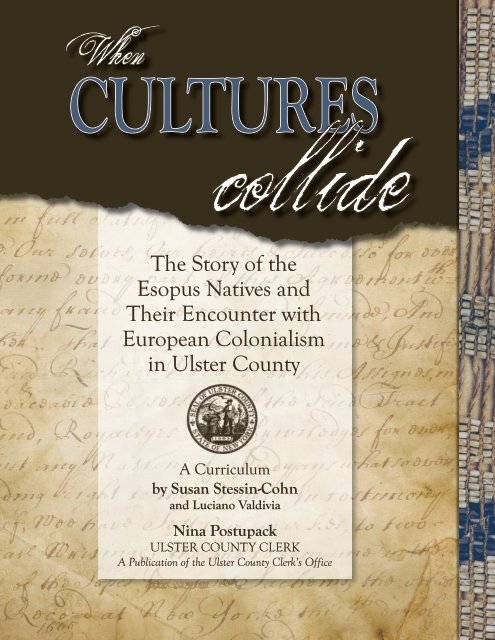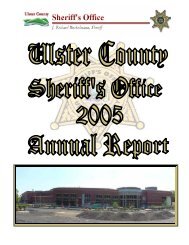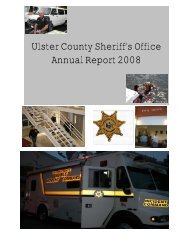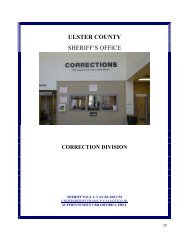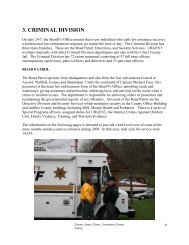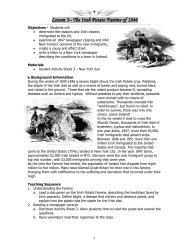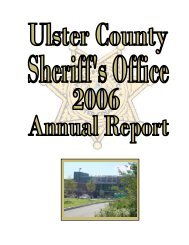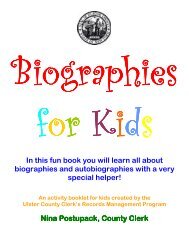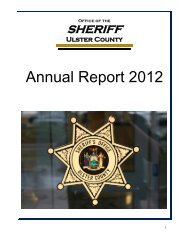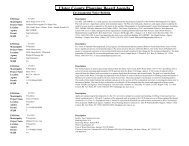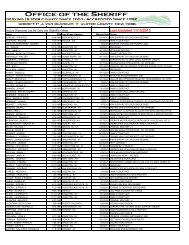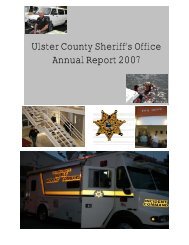The Story of the Esopus Natives and Their Encounter with European ...
The Story of the Esopus Natives and Their Encounter with European ...
The Story of the Esopus Natives and Their Encounter with European ...
Create successful ePaper yourself
Turn your PDF publications into a flip-book with our unique Google optimized e-Paper software.
When<br />
<strong>The</strong> <strong>Story</strong> <strong>of</strong> <strong>the</strong><br />
<strong>Esopus</strong> <strong>Natives</strong> <strong>and</strong><br />
<strong>The</strong>ir <strong>Encounter</strong> <strong>with</strong><br />
<strong>European</strong> Colonialism<br />
in Ulster County<br />
A Curriculum<br />
by Susan Stessin-Cohn<br />
<strong>and</strong> Luciano Valdivia<br />
Nina Postupack<br />
UlSTEr CoUNTy ClErk<br />
A Publication <strong>of</strong> <strong>the</strong> Ulster County Clerk’s Office
TABLE OF CONTENTS<br />
Introduction<br />
Acknowledgements<br />
<strong>The</strong> New York State Social<br />
Studies St<strong>and</strong>ards<br />
Where <strong>the</strong> Written Record<br />
Fails Us<br />
I<br />
llI<br />
IV<br />
VII<br />
Nicolls Treaty <strong>of</strong> 1665<br />
Lesson 1 – Artifact Stories 1<br />
Lesson 2 – Artifact Detective 3<br />
Artifact Chart 5<br />
Lesson 3 – Archaeology Field School 7<br />
Lesson 4 – What’s in a Name? 8<br />
Map <strong>of</strong> Ulster County 10<br />
Lesson 5 – Every Pot Tells a <strong>Story</strong> 12<br />
Lesson 6 – Using <strong>the</strong> Environment 15<br />
Using <strong>the</strong> Environment Activity Sheet 17<br />
Lesson 7 – <strong>The</strong> 1652 Thomas<br />
Chambers L<strong>and</strong> Deed 18<br />
Thomas Chambers L<strong>and</strong> Deed Document 20<br />
Thomas Chambers L<strong>and</strong> Deed Transcription 21<br />
Thomas Chambers L<strong>and</strong> Deed Activity Sheet<br />
<strong>and</strong> DBQ<br />
23<br />
Lesson 8 – Fisher/Rutgers L<strong>and</strong> Deed 25<br />
Fisher/Rutgers L<strong>and</strong> Deed Document -8a 28<br />
Fisher/Rutgers L<strong>and</strong> Deed Translation -8b 30<br />
Fisher/Rutgers L<strong>and</strong> Deed Transcription -8c 32<br />
Glossary <strong>of</strong> Terms -8d 34<br />
Goods Traded Activity Sheet -8e 35<br />
Trade Items Activity Sheet -8f 36<br />
Sachem’s Marks Activity Sheet -8g 38<br />
Lesson 9 – Governor Peter Stuyvesant<br />
Builds a Stockade 39<br />
Order to Build <strong>the</strong> Stockade Document Translation 42<br />
Order to Build <strong>the</strong> Stockade Transcription 43<br />
Order to Build <strong>the</strong> Stockade Document Excerpt –9a 44<br />
Stockade Document Excerpt Activity Sheet –9b 45<br />
Map <strong>of</strong> <strong>the</strong> Stockade –9c 46<br />
Map <strong>of</strong> <strong>the</strong> Stockade Activity Sheet –9d 47<br />
Letter from Sergeant Louwrens Activity Sheet –9e 49<br />
<strong>Esopus</strong> Sachem’s Quote <strong>and</strong> Activity Sheet –9f 50<br />
1659: A History <strong>of</strong> Kingston Activity Sheet –9g 51<br />
Stockade DBQ -9h 52<br />
Lesson 10 – <strong>The</strong> Richard Nicolls <strong>Esopus</strong><br />
Indian Treaty <strong>of</strong> 1665 53<br />
Nicolls Indian Treaty Document 56<br />
Nicolls Indian Treaty Transcription 61<br />
Lesson 11 – <strong>The</strong> Wampum Belt 63<br />
<strong>The</strong> Wampum Belt Activity Sheet –11a 66<br />
Excerpt from <strong>the</strong> 1677/78 Renewal -11b 67<br />
Design a Wampum Belt Activity Sheet –11c 68
Lesson 12 – Renewal <strong>of</strong> <strong>the</strong> <strong>Esopus</strong> Indian<br />
Treaty <strong>of</strong> 1665 69<br />
1712 Renewal <strong>of</strong> <strong>the</strong> Treaty Document 71<br />
1712 Renewal <strong>of</strong> <strong>the</strong> Treaty Transcription 74<br />
1712 Renewal <strong>of</strong> <strong>the</strong> Treaty Activity Sheet 76<br />
Lesson 13 – Scattered to <strong>the</strong> Four Winds 77<br />
Scattered to <strong>the</strong> Four Winds Report Checklist 79<br />
Instructions for Graduated Page Booklet 80<br />
Lesson 14 – <strong>The</strong> Artifact Conundrum 81<br />
Discussion Web Activity Sheet 83<br />
Resources 84<br />
• Image <strong>of</strong> <strong>the</strong> Wampum Belt, courtesy <strong>of</strong> <strong>the</strong> Ulster County Clerk’s Office<br />
• Representation <strong>of</strong> <strong>the</strong> stockade built by <strong>The</strong> Friend’s <strong>of</strong> Historic Kingston, photo courtesy<br />
<strong>of</strong> Luciano Valdivia<br />
• Nicolls Treaty, courtesy <strong>of</strong> <strong>the</strong> Ulster County Clerk’s Office
j<br />
hile walking down John Street in Kingston, New York, it can be<br />
difficult to imagine a l<strong>and</strong>scape <strong>with</strong>out <strong>the</strong> brick <strong>and</strong> limestone<br />
buildings protruding from <strong>the</strong> ground. It remains, however,<br />
that <strong>the</strong>re was a time when <strong>the</strong> paved streets <strong>of</strong> <strong>the</strong> Uptown District were grassy<br />
plateaus <strong>and</strong> dirt paths. Beneath <strong>the</strong> store-fronts <strong>and</strong> apartment buildings we know<br />
all too well, <strong>the</strong>re is an historical record that waits to be unear<strong>the</strong>d. Such was <strong>the</strong> case<br />
<strong>with</strong> <strong>the</strong> Persen House located just past <strong>the</strong> old Mohican Market where John Street<br />
meets Green Street. In <strong>the</strong> basement <strong>of</strong> this colonial stone house, an archeological<br />
study brought to light a treasure trove <strong>of</strong> historical artifacts. <strong>The</strong> building itself<br />
provides us <strong>with</strong> better underst<strong>and</strong>ing <strong>of</strong> colonial life, <strong>and</strong> early <strong>European</strong> settlers,<br />
while <strong>the</strong> artifacts found in <strong>the</strong> soil below connect us <strong>with</strong> <strong>the</strong> original <strong>Esopus</strong><br />
inhabitants. Scorched into <strong>the</strong> walls <strong>of</strong> <strong>the</strong> cellar, <strong>the</strong> destruction brought about by <strong>the</strong><br />
second <strong>Esopus</strong> War acts as <strong>the</strong> physical marker <strong>of</strong> <strong>the</strong> period when <strong>the</strong>se two cultures<br />
collided.<br />
With starkly different habits, rituals, <strong>and</strong> cultures, <strong>the</strong>se two societies were set<br />
on a collision course from <strong>the</strong> moment <strong>of</strong> <strong>the</strong> first contact between <strong>the</strong> <strong>Esopus</strong> natives<br />
<strong>and</strong> Hendrik Hudson in 1609. <strong>The</strong> Thomas Chambers l<strong>and</strong> deed, <strong>of</strong> 1652, marks <strong>the</strong><br />
beginning <strong>of</strong> a 200-year period <strong>of</strong> <strong>European</strong> l<strong>and</strong> appropriation. Often shrouded in<br />
<strong>the</strong> surreptitious language <strong>of</strong> legalism, <strong>the</strong> terms <strong>of</strong> <strong>the</strong>se agreements were <strong>of</strong>ten a<br />
source <strong>of</strong> fur<strong>the</strong>r conflict between <strong>the</strong>se disparate peoples. Gradually losing <strong>the</strong>ir<br />
customary methods <strong>of</strong> tool creation, <strong>the</strong> <strong>Esopus</strong> became increasingly dependant upon<br />
<strong>European</strong> goods. Along <strong>with</strong> <strong>the</strong>ir l<strong>and</strong>, <strong>the</strong> <strong>Esopus</strong> lost <strong>the</strong>ir material culture, <strong>and</strong> to<br />
a certain extent, <strong>the</strong>ir traditional way <strong>of</strong> life. In return for <strong>the</strong>se fertile tracts <strong>of</strong> l<strong>and</strong>,<br />
<strong>the</strong> <strong>Esopus</strong> received diseases such as small pox, along <strong>with</strong> addictions to <strong>European</strong><br />
firearms, steel, <strong>and</strong> liquor, which proved disastrous for native society. <strong>The</strong> story <strong>of</strong> <strong>the</strong><br />
<strong>Esopus</strong> people, as is <strong>the</strong> case <strong>with</strong> countless native societies in <strong>the</strong> Americas, is a tale <strong>of</strong><br />
enslavement, addiction, disease, <strong>and</strong> dislocation. After suffering seven ‘trails <strong>of</strong> tears,’<br />
<strong>the</strong> descendents <strong>of</strong> <strong>the</strong> <strong>Esopus</strong> natives have been living in cultural enclaves in Canada<br />
<strong>and</strong> in <strong>the</strong> reservations <strong>of</strong> Oklahoma, far away from <strong>the</strong>ir original homel<strong>and</strong>s in New<br />
York, New Jersey, Pennsylvania, <strong>and</strong> Delaware.<br />
I
Arranged chronologically, this curriculum begins <strong>with</strong> discussion <strong>of</strong> <strong>the</strong> earliest<br />
ancestors <strong>of</strong> <strong>the</strong> Lenape Nation, who arrived here 13,000 years ago — called Paleo-<br />
Indians. <strong>The</strong> first six activities, marked by <strong>the</strong> image <strong>of</strong> a projectile point in <strong>the</strong> top<br />
right corner <strong>of</strong> <strong>the</strong> page, use <strong>the</strong>se artifacts as <strong>the</strong> primary documents from which <strong>the</strong><br />
activities have been created. Activity Three, Archaeology Field School, includes a CD-<br />
ROM documenting several archaeological excavations in Ulster County. In addition,<br />
<strong>the</strong> CD-ROM contains several slides <strong>with</strong> images <strong>of</strong> local Native pottery, beads <strong>and</strong><br />
projectile points. <strong>The</strong> following eight activities use written documents, as indicated by<br />
<strong>the</strong> image <strong>of</strong> a drawn turtle, as <strong>the</strong> basis for <strong>the</strong> lesson. Using primary documents, free<br />
<strong>of</strong> a historian’s interpretation, it becomes <strong>the</strong> work <strong>of</strong> <strong>the</strong> student to assess <strong>the</strong>se<br />
documents from <strong>the</strong> past <strong>and</strong> provide <strong>the</strong>ir own view regarding <strong>the</strong>ir significance. In<br />
essence, <strong>the</strong> student becomes <strong>the</strong> historian, identifying <strong>the</strong> trends <strong>and</strong> meaning behind<br />
<strong>the</strong> collection <strong>of</strong> documents herein.<br />
@fâátÇ fàxáá|Ç@VÉ{Ç tÇw _âv|tÇÉ itÄw|ä|t<br />
Excavation <strong>of</strong> <strong>the</strong> Persen House, Fall 2000<br />
-photo taken by Dr. Joseph Diamond<br />
II
Acknowledgements<br />
This project was made possible through a grant to<br />
<strong>the</strong> Ulster County Clerk’s Office from <strong>the</strong> New<br />
York State Archives Local Government Records<br />
Management Improvement Fund.<br />
I would like to express my gratitude <strong>and</strong> appreciation to <strong>the</strong> many<br />
organizations <strong>and</strong> individuals who contributed <strong>the</strong>ir expertise <strong>and</strong><br />
encouragement in <strong>the</strong> production <strong>of</strong> this teaching packet.<br />
Ulster County Clerk’s Office, Kingston, NY<br />
Nina Postupack, Ulster County Clerk, for her constant support, encouragement,<br />
leadership <strong>and</strong> access to <strong>the</strong> records <strong>of</strong> <strong>the</strong> Ulster County Clerk’s Office<br />
Laurie Hancock, Deputy County Clerk <strong>and</strong> Records Management Officer, for her<br />
inspiration, enthusiasm <strong>and</strong> assistance for <strong>the</strong> project<br />
Ken Gray, Archival Processing Technician, for his extensive knowledge <strong>of</strong> <strong>the</strong><br />
Ulster County Clerk’s Archives<br />
Barbara Carlson, Index Clerk-Typist, for her creativity <strong>and</strong> computer assistance<br />
Lenape Elementary School, New Paltz, NY<br />
Linda Sinferoso, for advice <strong>and</strong> piloting <strong>the</strong>se activities <strong>with</strong> her fourth grade class<br />
SUNY at New Paltz, New Paltz, NY<br />
Dr. Joseph Diamond, for assistance in <strong>the</strong> project from <strong>the</strong> beginning to <strong>the</strong> end<br />
Dr. Rose Rudnitski, for her suggestions <strong>and</strong> support<br />
Havil<strong>and</strong>-Heidgerd Historical Collection at <strong>the</strong> Elting Library, New Paltz, NY<br />
Carol Johnson, Director, for access to <strong>the</strong> Library Collections<br />
Marion Ryan, Director <strong>of</strong> Collections, for access to <strong>the</strong> Library Collections<br />
<strong>The</strong> Senate House Museum, Kingston, NY<br />
Deana Preston, Historic Site Assistant for NYS Parks, Recreation <strong>and</strong> Historic<br />
Preservation, for assistance <strong>and</strong> access to <strong>the</strong> records <strong>of</strong> <strong>the</strong> Senate House<br />
Lisa Bruck, Administrative Assistant for NYS Parks, Recreation <strong>and</strong> Historic<br />
Preservation, for assistance <strong>and</strong> access to <strong>the</strong> records <strong>of</strong> <strong>the</strong> Senate House.<br />
New Paltz Central School District<br />
Sean Doyle, for his suggestions <strong>and</strong> support throughout <strong>the</strong> project<br />
Steve Comer, Stockbridge Munsee Nation, for reviewing <strong>the</strong> curriculum <strong>and</strong> <strong>of</strong>fering<br />
advice <strong>and</strong> suggestions<br />
Tamara Francis, Delaware Nation NAGPRA/Cultural Preservation Department, for<br />
providing historical information on <strong>the</strong> Delaware Nation<br />
III
New York State Learning St<strong>and</strong>ards for Social Studies<br />
St<strong>and</strong>ards 1 2 3 4 5 6 7 8 9 10 11 12 13 14<br />
St<strong>and</strong>ard 1: <strong>The</strong> History <strong>of</strong> <strong>the</strong> US <strong>and</strong> NY<br />
Key Idea 1<br />
PI - Know <strong>the</strong> roots <strong>of</strong> American culture <strong>and</strong> <strong>the</strong><br />
ways different people played a role in creating it.<br />
<br />
Key Idea 2<br />
PI – Ga<strong>the</strong>r <strong>and</strong> organize information about <strong>the</strong><br />
traditions transmitted by various groups living in<br />
<strong>the</strong>ir neighborhood <strong>and</strong> community.<br />
PI – Recognize how traditions <strong>and</strong> practices were<br />
passed from one generation to <strong>the</strong> next<br />
PI - Distinguish between near <strong>and</strong> distant past.<br />
<br />
<br />
<br />
<br />
<br />
<br />
<br />
<br />
<br />
<br />
<br />
<br />
<br />
<br />
<br />
<br />
<br />
<br />
<br />
<br />
<br />
<br />
<br />
<br />
<br />
<br />
<br />
Key Idea 3<br />
PI - Ga<strong>the</strong>r <strong>and</strong> organize information about <strong>the</strong><br />
important accomplishments <strong>of</strong> individuals <strong>and</strong><br />
groups, including Native America Indians, living in<br />
<strong>the</strong>ir neighborhoods <strong>and</strong> communities.<br />
Key Idea 4<br />
PI - Consider different interpretations <strong>of</strong> key events<br />
<strong>and</strong>/or issues in history <strong>and</strong> underst<strong>and</strong> <strong>the</strong><br />
differences in <strong>the</strong>se accounts.<br />
PI – Explore different experiences, beliefs, motives,<br />
<strong>and</strong> traditions <strong>of</strong> people living in <strong>the</strong>ir<br />
neighborhoods, communities <strong>and</strong> State.<br />
PI – View historic events through <strong>the</strong> eyes <strong>of</strong> those<br />
who were <strong>the</strong>re.<br />
St<strong>and</strong>ard 2: World History<br />
Key Idea 1<br />
PI – Explore narrative accounts <strong>of</strong> important<br />
events from world history to learn about different<br />
accounts <strong>of</strong> <strong>the</strong> past to begin to underst<strong>and</strong> how<br />
interpretations <strong>and</strong> perspectives develop.<br />
PI - Study about different world cultures <strong>and</strong><br />
civilizations focusing on <strong>the</strong>ir accomplishments,<br />
contributions, values, beliefs, <strong>and</strong> traditions.<br />
Key Idea 3<br />
PI - Interpret <strong>and</strong> analyze documents <strong>and</strong> artifacts<br />
related to significant developments <strong>and</strong> events in<br />
world history.<br />
PI - Underst<strong>and</strong> how <strong>the</strong> terms social, political,<br />
economic, <strong>and</strong> cultural can be used to describe<br />
human activities or practices.<br />
<br />
<br />
<br />
<br />
<br />
<br />
<br />
<br />
<br />
<br />
<br />
<br />
<br />
<br />
<br />
<br />
<br />
<br />
<br />
<br />
<br />
<br />
<br />
<br />
<br />
<br />
<br />
<br />
<br />
<br />
<br />
<br />
<br />
IV
New York State Learning St<strong>and</strong>ards for Social Studies<br />
St<strong>and</strong>ards 1 2 3 4 5 6 7 8 9 10 11 12 13 14<br />
Key Idea 4<br />
PI– Consider different interpretations <strong>of</strong> key<br />
events <strong>and</strong> developments in world history <strong>and</strong><br />
underst<strong>and</strong> <strong>the</strong> differences in <strong>the</strong>se accounts.<br />
PI - explore <strong>the</strong> lifestyles, beliefs, traditions, rules<br />
<strong>and</strong> laws, <strong>and</strong> social/cultural needs <strong>and</strong> wants <strong>of</strong><br />
people during different periods in history <strong>and</strong> in<br />
different parts <strong>of</strong> <strong>the</strong> world.<br />
PI – View historic events through <strong>the</strong> eyes <strong>of</strong><br />
those <strong>of</strong> those who were <strong>the</strong>re, as shown in <strong>the</strong>ir<br />
art, writings, music, <strong>and</strong> artifacts.<br />
St<strong>and</strong>ard 3: Geography<br />
Key Idea 1<br />
PI – Study about how people live, work, <strong>and</strong><br />
utilize natural resources.<br />
PI - Locate places <strong>with</strong>in <strong>the</strong> community.<br />
Key Idea 2<br />
PI - Ask geographic questions about where places<br />
are located; why <strong>the</strong>y are located where <strong>the</strong>y<br />
are; what is important about <strong>the</strong>ir locations; <strong>and</strong><br />
how <strong>the</strong>ir locations are related to <strong>the</strong> location <strong>of</strong><br />
o<strong>the</strong>r people <strong>and</strong> places (Adapted from National<br />
Geography St<strong>and</strong>ards, 1994.<br />
St<strong>and</strong>ard 4: Economics<br />
Key Idea 1<br />
PI – Know some ways individuals <strong>and</strong> groups<br />
attempt to satisfy <strong>the</strong>ir basic needs <strong>and</strong> wants by<br />
utilizing scarce resources.<br />
St<strong>and</strong>ard 5 – Civics, Citizenship, <strong>and</strong><br />
Government<br />
Key Idea 1<br />
PI – Know <strong>the</strong> meaning <strong>of</strong> key terms <strong>and</strong><br />
concepts related to government, including<br />
democracy, power, citizenship, nation-state, <strong>and</strong><br />
justice.<br />
Key Idea 4<br />
PI - Show a willingness to consider o<strong>the</strong>r points <strong>of</strong><br />
view before drawing conclusions or making<br />
judgments.<br />
PI - Suggest alternative solutions or courses <strong>of</strong><br />
action to hypo<strong>the</strong>tical or historic problems.<br />
<br />
<br />
<br />
<br />
<br />
<br />
<br />
<br />
<br />
<br />
<br />
<br />
<br />
<br />
<br />
<br />
<br />
<br />
<br />
<br />
<br />
<br />
<br />
<br />
<br />
<br />
<br />
<br />
<br />
<br />
<br />
<br />
<br />
<br />
<br />
V
Where <strong>the</strong> written record fails us. . . . . . . . .<br />
archeological evidence can fill in <strong>the</strong> gaps. Through material culture, we can gain<br />
an underst<strong>and</strong>ing <strong>of</strong> a particular society’s daily lifestyle, including diet, belief<br />
systems, <strong>and</strong> general culture. When attempting to establish an underst<strong>and</strong>ing <strong>of</strong><br />
<strong>the</strong> way a group or society functioned <strong>and</strong> lived, if <strong>the</strong>re is no formal written<br />
history to base our interpretation upon, we can only ga<strong>the</strong>r an appropriate<br />
picture from artifacts left behind.<br />
In essence, “artifacts” are products <strong>of</strong> human activity, such as projectile<br />
points, pottery, utensils, <strong>and</strong> ornaments. A tree branch, however, is not, unless <strong>of</strong><br />
course it has been altered by <strong>the</strong> human presence; carved, s<strong>and</strong>ed, sharpened etc.<br />
Likewise, a rock is not an artifact in itself, however becomes one after being<br />
chipped, carved, or smoo<strong>the</strong>d.<br />
Also useful in creating <strong>the</strong> framework for our underst<strong>and</strong>ing <strong>of</strong> cultures<br />
past, existing outside <strong>the</strong> written record, is “cultural debris.” Essentially <strong>the</strong><br />
“byproducts” <strong>of</strong> human interaction <strong>with</strong> <strong>the</strong> world around <strong>the</strong>m, <strong>the</strong>se discarded<br />
items, such as chipped stone flakes (debutage) <strong>and</strong> food residue, provide us <strong>with</strong><br />
indicators <strong>of</strong> how “artifacts” were made, as well as <strong>the</strong> foods consumed by <strong>the</strong><br />
society in question.<br />
Features, or footprints so to speak, are indicators below <strong>the</strong> ground’s<br />
surface which show <strong>the</strong> manmade structures where human activity took place,<br />
such as sub-floor pits where corn <strong>and</strong> o<strong>the</strong>r plant material would have been<br />
stored, post holes, burials, <strong>and</strong> cooking hearths.<br />
In conjunction, “artifacts,” “cultural debris,” <strong>and</strong> “features,” provide<br />
archeologists <strong>with</strong> <strong>the</strong> necessary groundwork to make intelligible conclusions<br />
concerning a particular group or society. <strong>The</strong> manner in which a people lived<br />
<strong>the</strong>ir daily lives, <strong>and</strong> more broadly, <strong>the</strong> <strong>the</strong>mes by which <strong>the</strong>ir existence can be<br />
exp<strong>and</strong>ed upon, can also be brought to light through <strong>the</strong>se three types <strong>of</strong> material<br />
remains.<br />
VII


